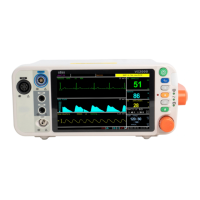Chapter 10: Respiration Rate
VS2000 Vital Signs Monitor Operation Manual 10-1
Chapter 10: Respiration Rate (Resp)
10.1 Respiration Rate Measurement Capability
The RESP parameter provides respiration rate (RPM) values. The measured
value for RESP is displayed in the RR parameter box.
For the respiratory measurement (Resp), the monitor measures the thoracic
impedance between two ECG electrodes on the patient’s chest. Changes in the
impedance due to thoracic movement produce the Resp waveform on the
monitor screen. The monitor counts the waveform cycles to calculate the
respiration rate (RR).
10.2 Respiration Rate Warnings, Cautions, and Notes
WARNING! Respiration monitoring is not recommended on active
patients. It may lead to false alarm.
WARNING! Install white and red electrodes in opposite positions to obtain
optimum respiration waveform. Avoid placing the cable above
liver and ventricle to reduce false readings produced by the
heart coverage or pulsation blood flow. This is very important
for neonates.
10.3 Attaching to the Patient
Correct patient skin preparation techniques for electrode placement are
important for Resp measurement: you will find this information in the chapter
on ECG.
The Resp measurement uses the standard ECG cable sets and lead placements.
You can use any of the different types of ECG cable sets to measure Resp, as
long as you use ICU ECG cables.
The Resp signal is always measured between two of the ECG electrodes. If you
are using standard ECG electrode placement, Resp is measured between the
RA and LL electrodes.
10.4 Choosing the Waveform Settings
10.4.1 Change the ECG Lead

